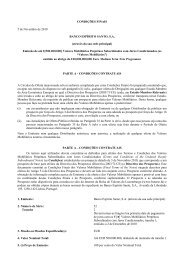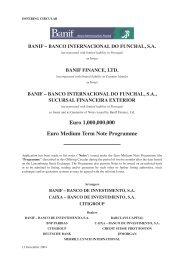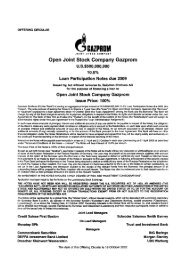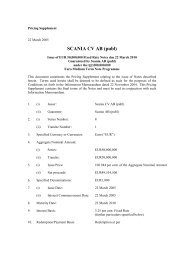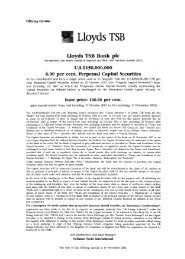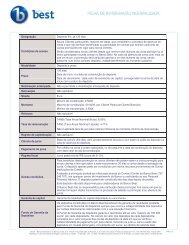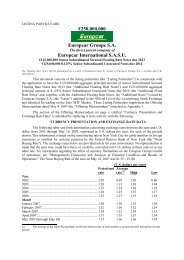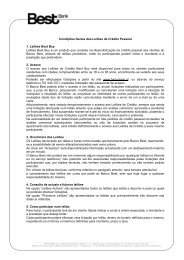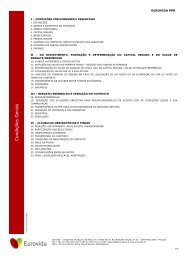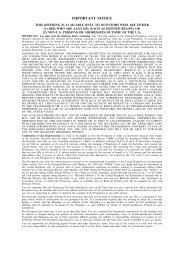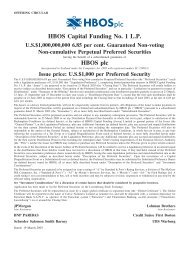Espírito Santo Investment p.l.c. Banco Espírito Santo de ... - BES
Espírito Santo Investment p.l.c. Banco Espírito Santo de ... - BES
Espírito Santo Investment p.l.c. Banco Espírito Santo de ... - BES
You also want an ePaper? Increase the reach of your titles
YUMPU automatically turns print PDFs into web optimized ePapers that Google loves.
In addition, Notehol<strong>de</strong>rs should be aware of the prevailing and wi<strong>de</strong>ly reported global credit market conditions<br />
(which continue at the date of this Offering Circular), whereby there is a general lack of liquidity in the secondary<br />
market for instruments similar to the Notes. Such lack of liquidity may result in investors suffering losses on the Notes<br />
in secondary resales even if there is no <strong>de</strong>cline in the performance of the assets of the relevant Issuer. The Issuers<br />
cannot predict which of these circumstances will change and whether, if and when they do change, there will be a more<br />
liquid market for the Notes and instruments similar to the Notes at that time.<br />
Exchange rate risks and exchange controls<br />
The relevant Issuer will pay principal and interest on the Notes in the Specified Currency. This presents certain<br />
risks relating to currency conversions if an investor's financial activities are <strong>de</strong>nominated principally in a currency or<br />
currency unit (the Investor's Currency) other than the Specified Currency. These inclu<strong>de</strong> the risk that exchange rates<br />
may significantly change (including changes due to <strong>de</strong>valuation of the Specified Currency or revaluation of the<br />
Investor's Currency) and the risk that authorities with jurisdiction over the Investor's Currency may impose or modify<br />
exchange controls. An appreciation in the value of the Investor's Currency relative to the Specified Currency would<br />
<strong>de</strong>crease (1) the Investor's Currency-equivalent yield on the Notes, (2) the Investor's Currency-equivalent value of the<br />
principal payable on the Notes and (3) the Investor's Currency-equivalent market value of the Notes.<br />
Government and monetary authorities may impose (as some have done in the past) exchange controls that could<br />
adversely affect an applicable exchange rate. As a result, investors may receive less interest or principal than expected,<br />
or no interest or principal.<br />
Interest rate risks<br />
<strong>Investment</strong> in Fixed Rate Notes involves the risk that subsequent changes in market interest rates may adversely<br />
affect the value of the Fixed Rate Notes.<br />
Credit ratings may not reflect all risks<br />
One or more in<strong>de</strong>pen<strong>de</strong>nt credit rating agencies may assign credit ratings to the Notes. The ratings may not<br />
reflect the potential impact of all risks related to structure, market, additional factors discussed above, and other factors<br />
that may affect the value of the Notes. A credit rating is not a recommendation to buy, sell or hold securities and may be<br />
revised or withdrawn by the rating agency at any time.<br />
Specific risks related to <strong>BES</strong>I's market<br />
Market risk is consi<strong>de</strong>red as the potential loss of value in a portfolio of financial instruments, arising from<br />
fluctuations in market variables such as credit spreads, interest rates, currency exchange rates, share and share-in<strong>de</strong>x<br />
prices and commodity prices. The market risk of <strong>BES</strong>I is i<strong>de</strong>ntified, valued, monitored and controlled by a specific<br />
business unit (the Risk Control Unit), which is fully in<strong>de</strong>pen<strong>de</strong>nt of <strong>BES</strong>I's business units. The Risk Control Unit is<br />
part of the Risk Department and reports directly to a board member and to the Executive Committee.<br />
The Risk Control Unit is responsible for proposing control checks, performing statistical analysis of the relevant<br />
risk factors, measuring market volatility, analysing liquidity and running sensitivity analysis on the business un<strong>de</strong>r<br />
consi<strong>de</strong>ration. In addition to the computation results, control checks are also measured against the track record of the<br />
business unit and its strategic objectives, thus reflecting <strong>BES</strong>I's appetite for each type of risk.<br />
Control checks are submitted to and approved by the Credit and Risk Committee (CRC) of each business unit<br />
and subsequently submitted for approval to the <strong>Espírito</strong> <strong>Santo</strong> <strong>Investment</strong> Executive Committee or CRC in Lisbon.<br />
Control checks are reviewed at least once a year or whenever justified by changes in strategic options or market<br />
conditions. To build a comprehensive as possible risk profile, several complementary risk management measures are<br />
used, such as stop loss and concentration limits. Risk management measures inclu<strong>de</strong> VaR and Stress Testing and<br />
sensitivity mo<strong>de</strong>ls inclu<strong>de</strong> BPV and “greeks” (Vega and Rho). The VaR mo<strong>de</strong>l is adjusted by a back-testing analysis.<br />
The implementation of risk management and control procedures <strong>de</strong>pends on the market and business to which they<br />
apply.<br />
In addition, the financial portfolio of <strong>BES</strong>I is comprised of some financial instruments where a reference market<br />
price is unavailable. In such cases, these financial instruments are valued using theoretical valuation mo<strong>de</strong>ls. The<br />
valuation mo<strong>de</strong>ls are subsequently employed to manage and control positions, namely to compare them against<br />
approved control checks.<br />
<strong>BES</strong>I also uses price testing methodology to:<br />
(i)<br />
(ii)<br />
review the mo<strong>de</strong>ls and examine their suitability;<br />
establish the reasonableness, in<strong>de</strong>pen<strong>de</strong>nce and consistency of the data used by the mo<strong>de</strong>ls;<br />
26



